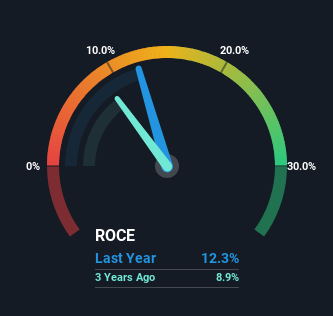Slowing Rates Of Return At Progressive Impact Corporation Berhad (KLSE:PICORP) Leave Little Room For Excitement
If you're not sure where to start when looking for the next multi-bagger, there are a few key trends you should keep an eye out for. Typically, we'll want to notice a trend of growing return on capital employed (ROCE) and alongside that, an expanding base of capital employed. Basically this means that a company has profitable initiatives that it can continue to reinvest in, which is a trait of a compounding machine. However, after briefly looking over the numbers, we don't think Progressive Impact Corporation Berhad (KLSE:PICORP) has the makings of a multi-bagger going forward, but let's have a look at why that may be.
Understanding Return On Capital Employed (ROCE)
For those that aren't sure what ROCE is, it measures the amount of pre-tax profits a company can generate from the capital employed in its business. To calculate this metric for Progressive Impact Corporation Berhad, this is the formula:
Return on Capital Employed = Earnings Before Interest and Tax (EBIT) ÷ (Total Assets - Current Liabilities)
0.12 = RM10m ÷ (RM184m - RM99m) (Based on the trailing twelve months to December 2023).
So, Progressive Impact Corporation Berhad has an ROCE of 12%. In absolute terms, that's a satisfactory return, but compared to the Commercial Services industry average of 5.9% it's much better.
View our latest analysis for Progressive Impact Corporation Berhad
Historical performance is a great place to start when researching a stock so above you can see the gauge for Progressive Impact Corporation Berhad's ROCE against it's prior returns. If you're interested in investigating Progressive Impact Corporation Berhad's past further, check out this free graph covering Progressive Impact Corporation Berhad's past earnings, revenue and cash flow.
So How Is Progressive Impact Corporation Berhad's ROCE Trending?
Over the past five years, Progressive Impact Corporation Berhad's ROCE has remained relatively flat while the business is using 26% less capital than before. To us that doesn't look like a multi-bagger because the company appears to be selling assets and it's returns aren't increasing. So if this trend continues, don't be surprised if the business is smaller in a few years time.
On another note, while the change in ROCE trend might not scream for attention, it's interesting that the current liabilities have actually gone up over the last five years. This is intriguing because if current liabilities hadn't increased to 54% of total assets, this reported ROCE would probably be less than12% because total capital employed would be higher.The 12% ROCE could be even lower if current liabilities weren't 54% of total assets, because the the formula would show a larger base of total capital employed. Additionally, this high level of current liabilities isn't ideal because it means the company's suppliers (or short-term creditors) are effectively funding a large portion of the business.
In Conclusion...
It's a shame to see that Progressive Impact Corporation Berhad is effectively shrinking in terms of its capital base. And investors appear hesitant that the trends will pick up because the stock has fallen 23% in the last five years. All in all, the inherent trends aren't typical of multi-baggers, so if that's what you're after, we think you might have more luck elsewhere.
One more thing: We've identified 3 warning signs with Progressive Impact Corporation Berhad (at least 2 which can't be ignored) , and understanding these would certainly be useful.
If you want to search for solid companies with great earnings, check out this free list of companies with good balance sheets and impressive returns on equity.
Have feedback on this article? Concerned about the content? Get in touch with us directly. Alternatively, email editorial-team (at) simplywallst.com.
This article by Simply Wall St is general in nature. We provide commentary based on historical data and analyst forecasts only using an unbiased methodology and our articles are not intended to be financial advice. It does not constitute a recommendation to buy or sell any stock, and does not take account of your objectives, or your financial situation. We aim to bring you long-term focused analysis driven by fundamental data. Note that our analysis may not factor in the latest price-sensitive company announcements or qualitative material. Simply Wall St has no position in any stocks mentioned.

